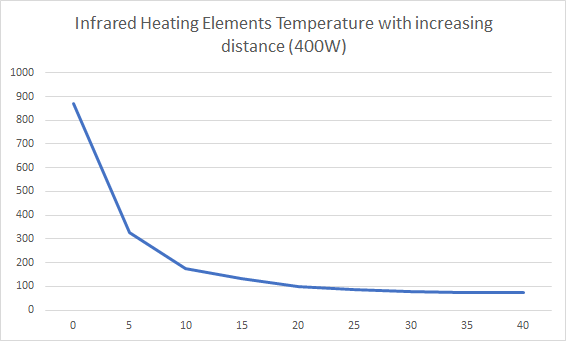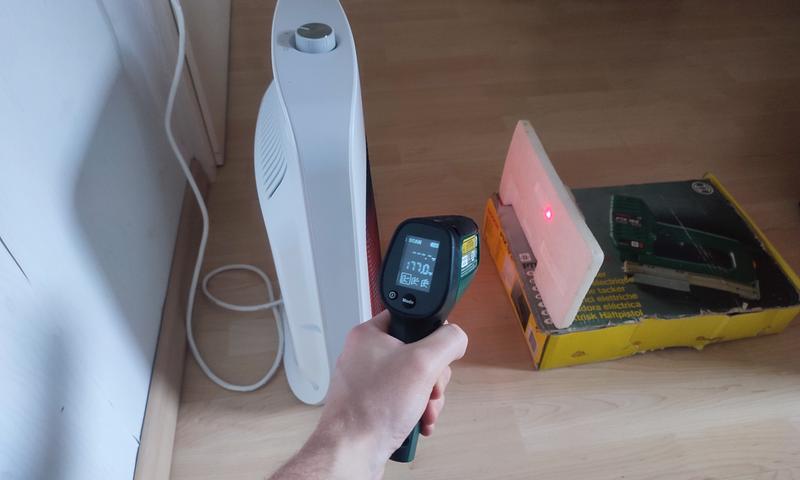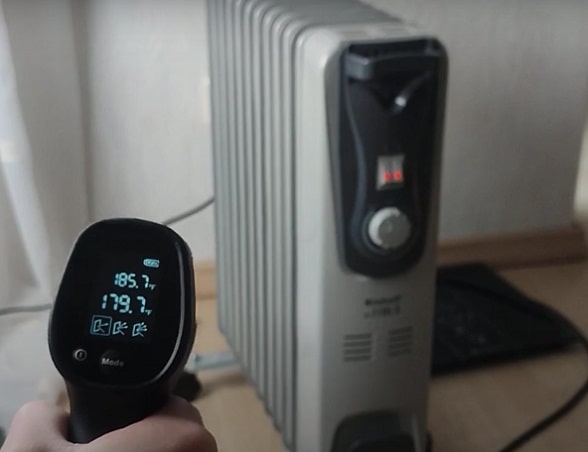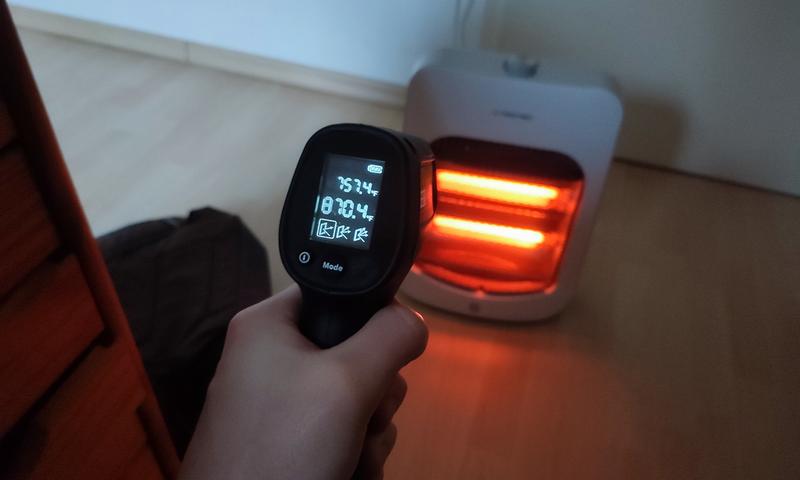Are infrared heaters safe to use indoors? Can they be a fire hazard? In this article, I am going to tell you exactly how hot infrared heaters get, which materials they can ignite and whether they can start a fire on their own.
Additionally, I will tell you how to safely run an infrared heater. And we will check whether you really need an infrared heater (because there is a safer space heater type).
Quick answer: Electric infrared heaters are safe to use indoors. Don’t place any objects right in front of the infrared heater, as infrared radiation in close proximity to the heater is hot enough to ignite plastic. So, use your infrared heater reasonably. If you can’t enforce reasonable usage because you have kids or pets at home, you should get an oil-filled radiator instead. They are safer than infrared heaters because they have much lower surface temperatures.
Recommended safest infrared heater
My recommended safest infrared heater is the Dr. Infrared Heater DR-968 (click here to view it on amazon).
It’s significantly safer than other infrared heaters because its case is made of real wood.
Now, some of you might wonder… “Doesn’t wood burn?”. Yes, at some point all materials will ignite. The difference is the ignition temperature.
Most plastic materials start melting around 250°F (120°C), whereas wood only ignites above 1100°F (600°C).
Infrared heating elements get very hot (>750°F). So, using a case material with a high ignition temperature reduces the chance of self-ignition.
Which infrared heaters are safe indoors?
In general, all electric infrared heaters are safe to use indoors. Usually, infrared heaters have similar standard safety features (overheat protection, tip-over protection, etc.).
More expensive models won’t get you more safety features.
However, expensive models likely have better case materials. For example, there are no infrared heaters with wooden cases below the price point of a Dr. Infrared Heater.
By spending more, you get better materials.
Still, even cheap infrared heaters are usually sufficiently safe. Of course, you have to consider the quality of your infrared heater when using it.
I wouldn’t trust a $20 Walmart heater to keep my child’s bedroom warm overnight.
Which infrared heaters are dangerous indoors?
Usually, when people refer to “infrared heaters”, they mean “electric infrared heaters”.
However, the spectrum of infrared heaters is a bit broader than that. Aside from electric infrared heaters, there are also gas and fuel-based infrared heaters.
Some of them are safe, such as the Mr. Heater Big Buddy (click to read my review). However, some of those gas-based heaters should only be used outdoors.
Usually, when you are looking at a heater’s sales page, you’ll find the word “outdoor” when it is intended for outdoor use only.
The reason some of those gas and fuel-based heaters are not safe to use indoors is that there is a risk of carbon monoxide production.
If the heater is imperfectly adjusted, it can’t burn the gas or fuel ideally, which causes incomplete combustion.
This incomplete combustion produces toxic waste gases that you don’t want to have indoors.
Anyways. I assume you are looking for an indoor-safe electric space heater.
So, let’s have a look at why indoor electric space heaters can be dangerous as well.
What makes infrared heaters more dangerous than other space heaters?
Infrared heaters are not the safest type of space heater!
Infrared heaters differ significantly from other space heaters in one aspect. This aspect is both an advantage and a disadvantage. It’s this:
Infrared heat distribution
Infrared heaters radiate the heat in one direction. They don’t heat a room evenly. Instead, they heat the objects and people standing in front of them.
Infrared heaters, therefore, have a directional heat distribution.
Directional heat distribution is good when you look at efficiency. Instead of heating the entire room evenly, infrared heaters heat only an area of the room.
This increases the perceived efficiency. Since the heat reaches you in a “bundled” ray package, it feels a lot warmer than if it is spread evenly.
The downside of the focused heat is, however, that the temperatures in front of an infrared heater are very high.
I’ve done an experiment.
I placed a styrofoam block at different distances in front of an infrared heater an measured the styrofoam block’s temperature using a laser thermometer.
Here’s the result.

As you can see, infrared heaters get very hot in close proximity! My styrofoam block started smoking and melting as soon as I placed it closer than 5 inches to the infrared heater.
I removed the styrofoam immediately.
The incredibly high temperatures in front of the heating elements make an infrared heater one of the unsafest electric indoor space heaters.
Exposed heating elements
Another disadvantage of infrared heaters is their exposed heating elements.
The heating elements of infrared heaters always have to be open & visible. Otherwise, the radiation can’t easily escape the infrared heater.
The exposed heating elements go hand in hand with the heat distribution. They are what cause the high temperatures in close proximity to an infrared heater.
The heating elements are hot enough to cause pet fur to smoke. I’ve seen images of cats starting to smoke when laying in front of infrared heaters. The same would be true for dogs, birds, and other pets.
Also, kids can easily burn their fingers on the heating elements.
Now, it’s usually not possible to touch the heating elements directly. There’s a thin metal security grid in front of the heating elements.
But as you know, metal conducts heat very well. Touching the grid would be the same as touching a hot frying pan.

Can infrared heaters cause a fire?
Infrared heaters can only start a fire if you place an object with a low ignition temperature (such as plastic or styrofoam) right in front of it at a distance of under 5 inches.
Within this radius, infrared radiation is still very focused. It can cause sensitive objects to heat up above their melting and ignition temperature.
However, I can think of no scenario where any reasonable person would place an object immediately in front of a running infrared heater.
As long as you use your infrared heater reasonably, there is no risk of fire.
Which space heaters are safer than infrared heaters?
Oil-filled radiators are a lot safer than infrared heaters. When you have pets or kids at home, it is no question that you should always choose an oil-filled radiator over an infrared heater.
Oil-filled radiators do not have any exposed heating elements. Instead, they have a large metal heating body.
This metal body contains oil and a heating element. The heating element heats the oil. And the oil carries the heat evenly to the large metal surface.
This even heat distribution ensures that the surface temperature of an oil-filled radiator does not exceed 170°F (80°C).
Now, this is still hot to the touch. But it will neither hurt you nor will it cause a fire.
And on top of that, oil-filled radiators distribute the heat evenly in all directions. They don’t focus the heat radiation as infrared heaters do.
Here you have to keep in mind that an oil-filled radiator will heat your room to the same temperature as an infrared heater.
The amount of heat an oil-filled radiator releases matches the amount of heat that an infrared heater releases (1,500W for both).
So, your room will get equally warm with both heaters.
Personally, I prefer oil-filled radiators for whole-room heating, and I prefer infrared heaters when I want to focus heat toward me (for example toward my desk when I am working).

How to safely run an infrared heater
So far we’ve seen that infrared heaters are not the safest type of space heaters. However, this doesn’t mean that they are dangerous.
You just have to use them correctly.
Free up the space before your infrared heater
The area right before an infrared heater can get very hot if you block it with an object. If you don’t place anything in front of your infrared heater, the heat radiation continues to spread and does not overheat anything.
Make sure that the space before your infrared heater is free. Ideally, there should be no object blocking the infrared radiation between you and the infrared heater.
This way you don’t waste energy, no object in the way heats up, and you get the most of your infrared heater.
Rotate the infrared heater toward you
Infrared heat is most efficient when it radiates directly at you. So, I recommend you place your infrared heater to face you directly.
This way you don’t waste energy, and, even more importantly, you notice when the heater settings are too high.
Since infrared heaters bundle the radiation, you don’t really notice a heater overheating when it radiates the heat away from you.
When you point your heater at you and notice it’s too warm, you can lower the settings, save energy and improve the safety and longevity of your infrared heater.
Which safety features do electric infrared heaters have?
Infrared heaters have the same safety features that other space heaters also have.
They usually come with built-in overheat protection that automatically shuts off the heater when the internal temperature rises too high.
Also, many infrared heaters have a built-in thermostat that adapts the heating output to your room’s current temperature. If your room is already hot, the thermostat notices and reduces the heating.
And infrared heaters usually have a built-in tip-over protection. Tip-over protection is a switch that automatically shuts off the heater when you tip it over or when it falls over.
Tip-over protection is arguably the most important safety feature in an infrared heater, because of the exposed heating elements.
In the worst case, your infrared heater tips over, and its hot heating elements touch the carpet and possibly cause a fire.
In this case, they have to shut off quickly. Ideally, before they even touch the ground.
Conclusion
I feel like I made infrared heaters sound like very dangerous infrared heaters in this article.
Actually, I am using my infrared heater almost daily. And I never had any problems with it.
Yes, there was one time when a styrofoam block started smoking after I placed it in front of the infrared heater. However, that was in the context of an experiment. Never would I place anything right in front of my infrared heater.
So:
As long as you use your infrared heater reasonably, it is a perfectly safe space heater.
Infrared heaters only become problematic when you block the area right in front of them.
Avoid this and you are fine.

